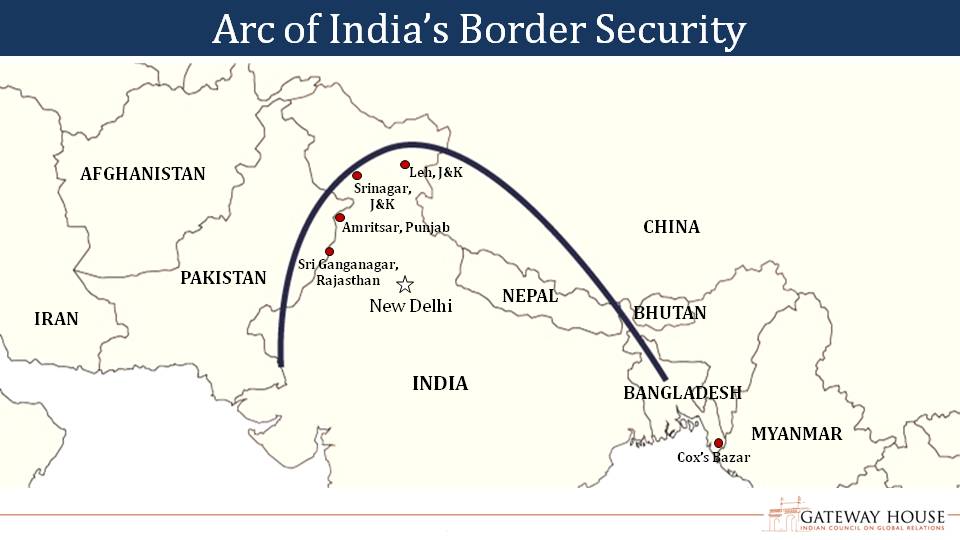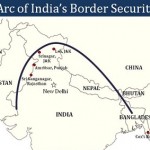Border regions and communities, some of them far from the heartland, constitute India’s first line of defence, a critical link in its national security. India’s 15,000-km land borders touch seven neighbouring countries: Afghanistan (abutting Gilgit), Pakistan, Nepal, Bhutan, China, Bangladesh, Myanmar.
Border regions have their own local dynamics, often shaped by subnational and religious identities that do not necessarily align neatly with political borders. Some also serve as flourishing corridors for illegal smuggling of goods and humans. Technology plays an important role in better protecting borders, but in some cases it has made borders obsolete. Despite their importance, border regions do not receive the full attention of the Indian mainstream, except when border tensions arise.
This repository on India’s border security, based on research and travel of Gateway House scholars, examines the critical challenges India faces in securing and maintaining its borders.

China targets India’s Ladakh
By Sameer Patil, Director, Centre for International Security & Fellow, National Security Studies, Gateway House
With India distracted in the Kashmir Valley, the critical border region of Ladakh has become a target of Chinese attention. Beijing appears to be exploiting Buddhist sectarian rivalries as it did in Tibet. Read more
Pakistani satellites eye India
By Chaitanya Giri, Fellow, Space and Ocean Studies, Gateway House
Pakistan is about to launch two military satellites in June with aid from China. It is pursuing its renewed space programme, using the same clandestine tactics it used for developing its atomic programme. Read more
Astro-diplomacy over Himalayan plateau
By Chaitanya Giri, Fellow, Space and Ocean Studies, Gateway House
Modern astronomy will stimulate scientific, technological, economic and human resource development—all high priorities for India. New Delhi should exploit its proximity to the ‘Roof of the World’ to advance its geopolitical interests. Read more
Punjab’s unshakable drug smuggling networks
By Sameer Patil, Director, Centre for International Security & Fellow, National Security Studies, Gateway House
Since 2017, the Punjab government has been cracking down on drug networks. The campaign has so far targeted small-time drug peddlers, but deep smuggling networks that cross international as well as state borders remain intact, posing a major national security threat. Read more
China’s strategic edge in covert communications
By Chaitanya Giri, Fellow, Space and Ocean Studies, Gateway House
China is steadily deploying state-of-the-art communications systems to connect its strategic and economic assets in Asia. It is then linkingthe Asian mainland to Africa, and Africa to South America. The investment spree is rapidly making Beijing a major player in global telecommunications – and ‘informationisation warfare’. Read more | View the Infographic
Khalistan 2.0: revival of Sikh separatism
By Sameer Patil, Director, Centre for International Security & Fellow, National Security Studies, Gateway House
Radical Sikh elements within the Indian diaspora have found the permissive political climate in Canada, North America and Europe conducive to building a support base in their respective countries, while donations from gurdwaras abroad and social media propaganda have fuelled separatist efforts in Punjab. India may have to step with care, containing the hostile propaganda, yet not appearing too stern in its response. Read more
The Rohingyas and India’s difficult choices
By Sameer Patil, Director, Centre for International Security & Fellow, National Security Studies, Gateway House
A recent trip to Cox’s Bazar showed that despite numerous health, social and security challenges, the Rohingya refugees are reluctant to return to Myanmar. India will have to walk a tightrope, keeping in mind humanitarian, security, and geopolitical priorities. Read more
India-China stand-offs
By Sameer Patil, Director, Centre for International Security & Fellow, National Security Studies & Kartik Jaishanker, former Intern, Gateway House
Since mid-June, India and China have been locked in an intense stand-off in the Doklam plateau, at the tri-junction of Bhutan, India, and China. Gateway House chronicles previous border incursions and transgressions by China into India’s territory and mentions relevant treaties and agreements. Read more | View the Infographic
How ‘hawala’ impacts national security
By Sameer Patil, Director, Centre for International Security & Fellow, National Security Studies, Gateway House
On November 8, when Prime Minister Narendra Modi announced to India, the demonetisation of high-value currency notes, he specifically referred to the use of Hawala and fake Indian currency notes for terrorist financing. The hawala system to move funds globally for terrorist financing is huge, secretive, and layered—and a challenge for national security agencies. Read more
Challenges in protecting the border
By Sameer Patil, Director, Centre for International Security & Fellow, National Security Studies, Gateway House
A recent seminar on ‘Countering Violent Extremism’ (CVE) offered a platform for law enforcement agencies to understand technological, social media and other propaganda strategies used by cross-border terrorist groups. The seminar’s location in Sri Ganganagar, the northern-most town of Rajasthan, served as a gentle reminder of challenges specific to security agencies on the India-Pakistan border. Read more
Pre-election flood of fake currency
By Sameer Patil, Director, Centre for International Security & Fellow, National Security Studies, Gateway House
Fake currency, widely in circulation in India, has become a serious threat with counterfeiters taking advantage of the election season to pump in more money. India has implemented counter-measures, but must utilise advanced techniques and sensitise local law enforcement machinery to counter the menace. Read more
© Copyright 2018 Gateway House: Indian Council on Global Relations. All rights reserved. Any unauthorized copying or reproduction is strictly prohibited.


